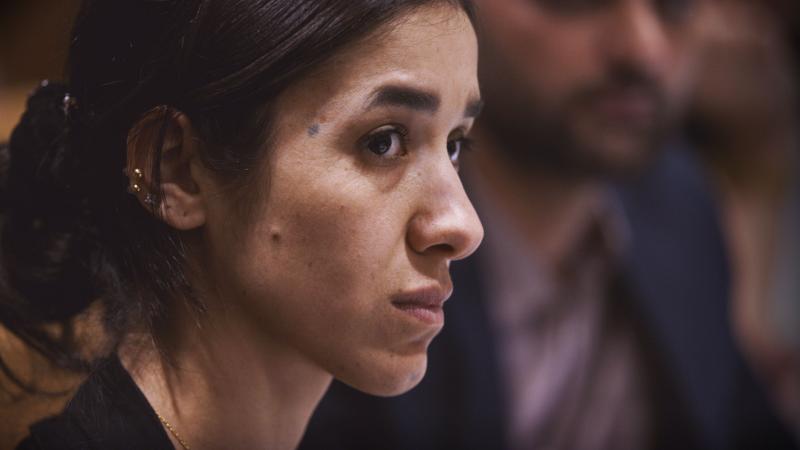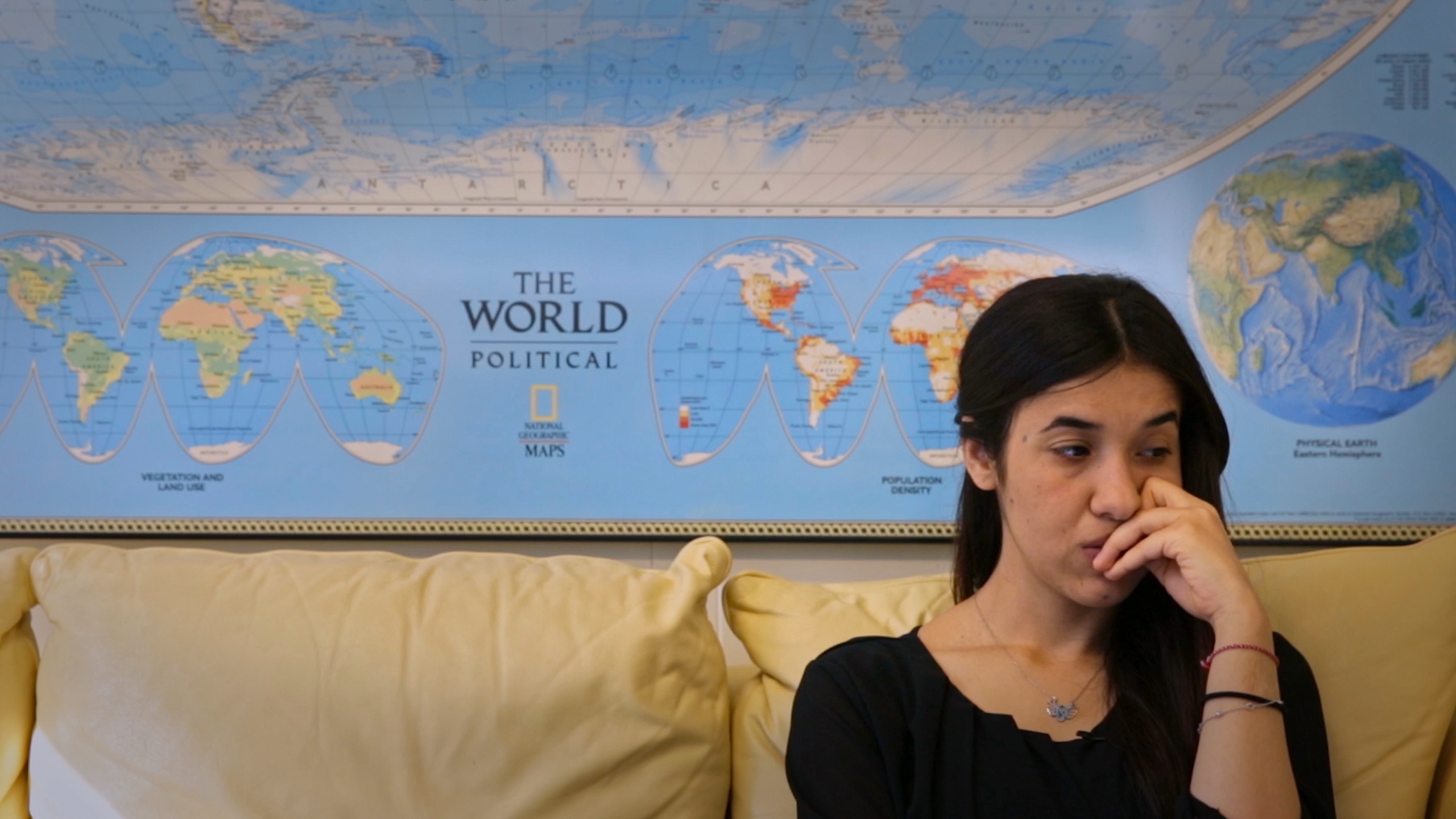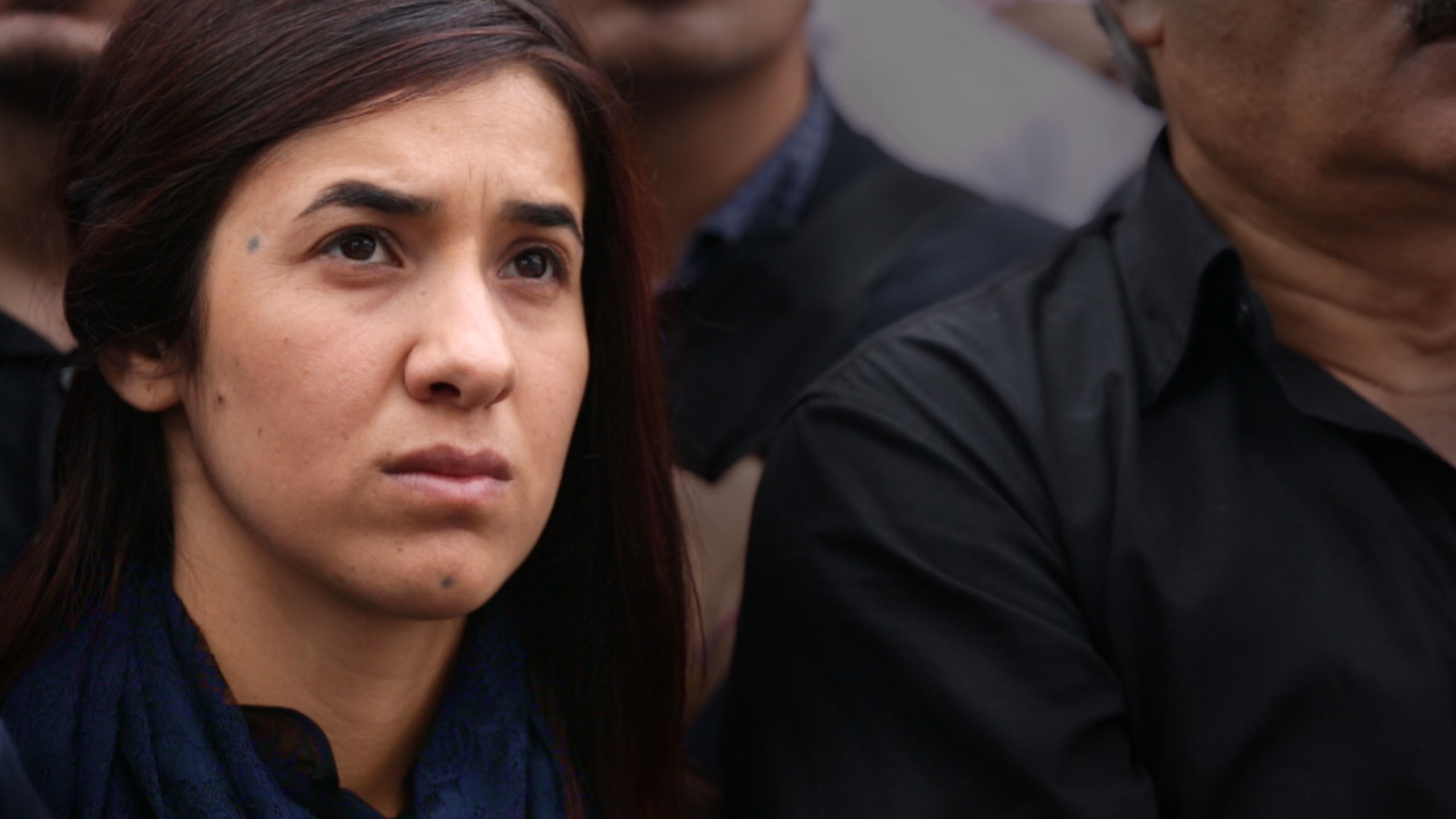Director Alexandria Bombach: 'I feel like a completely different person' | reviews, news & interviews
Director Alexandria Bombach: 'I feel like a completely different person'
Director Alexandria Bombach: 'I feel like a completely different person'
Director of On Her Shoulders on filming Yazidi campaigner Nadia Murad

Nadia Murad caught the world’s attention when she spoke at the United Nations Security Council. She spoke of living under ISIS, daily assaults, escaping, and the current plight of the Yazidi people, in refugee camps and still under ISIS control. It was a heart-breaking plea for support to the world’s silent nations.
On Her Shoulders is a new documentary about Nadia’s plight, and specifically the amount of travelling, planning and interviewing she subjects herself to just to keep the Yazidi in the news. From debuting director Alexandria Bombach, it’s an intensely personal and engrossing watch. Politicians offer dead-eye platitudes while she’s forced to relive her trauma. It’s a subtle but damning insight into the politics of international aid.
The film debuted at Sundance Film Festival in 2018, and is released in the UK this Friday. Bombach is currently in Britain filming her next feature, and spoke to The Arts Desk about what she learned from her time with Nadia.
OWEN RICHARDS: When did you first become aware of Nadia Murad?
ALEXANDRIA BOMBACH: I saw a video of her when she spoke at the UN Security Council for the first time in September 2015. It was such a powerful speech and testimony that it really got under my skin, I couldn’t stop thinking about it. I remember seeing the news was covering the beginning of the genocide in August 2014, and I was very moved by it. It wasn’t until July 2016 that I actually was asked by Riot Film Productions to make a short film about Nadia. I went and shot like crazy, and it turned into a feature. What was your first contact with her like?
What was your first contact with her like?
I had never filmed anyone with this level of experience of trauma before, so I was very cautious and tried to prepare as much as I could for that. Nadia’s very used to media, but documentary is a different type of storytelling, so in our initial meeting I was just explaining that I would be around all the time. The team had already given permission to film, but I wanted to sit and ask her again. I really expected a longer conversation but she agreed right away and didn’t seem fazed by it. That was just a sign of how desperate the campaign was at that point for anyone to pay attention. It was part of Nadia’s push to get everyone’s eyes and ears on this, as much as she possibly could. It was less about my attention than anybody’s she could.
How did your relationship develop from her just using this as a way to spread her message?
We were in very close quarters for almost three months. Of course, we got to know her pretty well, but this was someone who from very early in the morning to very late at night was so busy. From meetings to testimonies to interviews - a constant barrage of people trying to get this story out there. It was exhausting work for her, so I really did try to give her as much space as possible, even if we were in close quarters. What was it like becoming part of that world?
What was it like becoming part of that world?
It was a difficult film to shoot because of the context of her story, but also because I didn’t want to just be another person that was just taking from her. That’s a good reason why the film is edited and made the way it is, and talks about the things that it does. This was my first time witnessing an advocacy campaign behind the scenes, trying to get the world to care about a genocide. It was my first time seeing these kinds of meetings and watching another storyteller or journalist interview someone who has been through this kind of trauma. Also, my first time seeing behind the scenes of the UN, so it was difficult to not recognise as a part of that same world she was having to deal with. It was difficult to ask her every day to put the mic on and participate in this because I knew she was already handling so much.
The film gives a rare insight into how institutions like the UN work. Did you learn anything from seeing that from her point of view?
Completely. Not only how it works, but I feel like a completely different person. Being with these people taught me a lot about injustice and the problematic ways in how we tell these stories. It was a real eye-opener on advocacy and empathy in general.
There are times when Nadia is with these smiling politicians that are quite surreal. Did you sense that awkwardness there in the room when filming?
Oh definitely. With any kind of film I’m making, I try to pay attention to how I felt in the moment. That’s why they’re in the film because they stood out to me when I was there. A big part of the decision process for the edit was not necessarily trying to get the audience to understand how Nadia feels, because I think that would be disingenuous because we can’t really understand that. She’s been through such horrific things and has such a unique experience, it’s difficult for anybody to understand what she’s going through.
In the edit, I was really focusing on how I was feeling in those moments, witnessing this from a very close proximity but removed in the same way. Just observe what she was going through, and that’s the tent poles of the film – these odd observations of what Nadia has to go through to get the world to listen.
The sound design of the film gives scenes a real dreamlike quality. Did you have any particular influences when you were putting that edit together?
I should say my additional editor Michael Bucuzzo and sound editor Lawrence Everson were crucial partners in that sound design. It was so critical to all of us, and even my composer Patrick Jonsson, to respect silence and use that as a tool. Have these juxtapositions of sound and silence that can reinforce the juxtaposition of her life chaos and inner thoughts. For me, The Look of Silence was a huge influence on me, as was Fire at Sea. I don’t know if I can articulate why, but I watched those films many times while I was making this film. Did you have a clear idea of how the documentary would look ahead of filming?
Did you have a clear idea of how the documentary would look ahead of filming?
I didn’t know how it was going to look, but I had seen so many interviews of Nadia done by the news media that I didn’t want to do the same kind of interview set-up shot, with her in two-thirds of the frame. It was a little bit intimidating because I’d never done this process, but it was important to me to do the interview with her looking directly into the lens, directly at the audience.
There’s so much that audiences today ingest about the refugee crisis and there’s lots of apathy building toward these kinds of issues, allowing a separation from them. I wanted this film to be confronting. Not let you look away, so in a literal sense I’m having Nadia look directly at the audience, and I decided to stay pretty close to her with the lens for most of the shots. I wanted people to feel physically close to her.
Nadia always says she wants to move attention away from herself and onto refugees and the women still living under ISIS, but it’s a very personal film. How did she feel about being that lead subject?
She saw the film a few months before Sundance, and I think she was pretty blown away by it. She was surprised, because a lot of the media she’s seen on herself is about her captivity. She told me she was really happy the film is called On Her Shoulders instead of being called “Nadia”. She recognised the power of telling a story about the work, showing something different, and to get people to face what’s not being done. Showing what Nadia and her people have to do versus just focusing on the experience that she survived. She really appreciated that side of it.
Have members of the Yazidi community seen the film?
Every now and then I’ll be at a screening, and have Yazidi people there, and the films available on iTunes in the United States now, so more and more are seeing the film. The reaction as been nothing but positive, and I’m really thankful for that because it’s dedicated to the Yazidi people. It was really important for me to show them as much respect as possible and so far it’s been a very positive response.
You’re in the UK currently filming your next project. What’s that about?
I’m making a film about a band. They’re not crazy popular in Europe, they’re called The Indigo Girls, and they’re doing their next album at Real World studios in London. They’re really big in the States but not so big over here. This is my first shoot with them. All of 2018 I was on the road for On Her Shoulders, and I’m doing the last bits of interviews and release stuff for that now. Then I can move on to a happier film. But it’s a very privileged thing for me to say, because Nadia and her work has completely ramped up and this is going to be much of her life.
Explore topics
Share this article
The future of Arts Journalism
You can stop theartsdesk.com closing!
We urgently need financing to survive. Our fundraising drive has thus far raised £49,000 but we need to reach £100,000 or we will be forced to close. Please contribute here: https://gofund.me/c3f6033d
And if you can forward this information to anyone who might assist, we’d be grateful.

Subscribe to theartsdesk.com
Thank you for continuing to read our work on theartsdesk.com. For unlimited access to every article in its entirety, including our archive of more than 15,000 pieces, we're asking for £5 per month or £40 per year. We feel it's a very good deal, and hope you do too.
To take a subscription now simply click here.
And if you're looking for that extra gift for a friend or family member, why not treat them to a theartsdesk.com gift subscription?
more Film
 theartsdesk Q&A: director Kelly Reichardt on 'The Mastermind' and reliving the 1970s
The independent filmmaker discusses her intimate heist movie
theartsdesk Q&A: director Kelly Reichardt on 'The Mastermind' and reliving the 1970s
The independent filmmaker discusses her intimate heist movie
 Blu-ray: Wendy and Lucy
Down-and-out in rural Oregon: Kelly Reichardt's third feature packs a huge punch
Blu-ray: Wendy and Lucy
Down-and-out in rural Oregon: Kelly Reichardt's third feature packs a huge punch
 The Mastermind review - another slim but nourishing slice of Americana from Kelly Reichardt
Josh O'Connor is perfect casting as a cocky middle-class American adrift in the 1970s
The Mastermind review - another slim but nourishing slice of Americana from Kelly Reichardt
Josh O'Connor is perfect casting as a cocky middle-class American adrift in the 1970s
 Springsteen: Deliver Me From Nowhere review - the story of the Boss who isn't boss of his own head
A brooding trip on the Bruce Springsteen highway of hard knocks
Springsteen: Deliver Me From Nowhere review - the story of the Boss who isn't boss of his own head
A brooding trip on the Bruce Springsteen highway of hard knocks
 The Perfect Neighbor, Netflix review - Florida found-footage documentary is a harrowing watch
Sundance winner chronicles a death that should have been prevented
The Perfect Neighbor, Netflix review - Florida found-footage documentary is a harrowing watch
Sundance winner chronicles a death that should have been prevented
 Blu-ray: Le Quai des Brumes
Love twinkles in the gloom of Marcel Carné’s fogbound French poetic realist classic
Blu-ray: Le Quai des Brumes
Love twinkles in the gloom of Marcel Carné’s fogbound French poetic realist classic
 Frankenstein review - the Prometheus of the charnel house
Guillermo del Toro is fitfully inspired, but often lost in long-held ambitions
Frankenstein review - the Prometheus of the charnel house
Guillermo del Toro is fitfully inspired, but often lost in long-held ambitions
 London Film Festival 2025 - a Korean masterclass in black comedy and a Camus classic effectively realised
New films from Park Chan-wook, Gianfranco Rosi, François Ozon, Ildikó Enyedi and more
London Film Festival 2025 - a Korean masterclass in black comedy and a Camus classic effectively realised
New films from Park Chan-wook, Gianfranco Rosi, François Ozon, Ildikó Enyedi and more
 After the Hunt review - muddled #MeToo provocation
Julia Roberts excels despite misfiring drama
After the Hunt review - muddled #MeToo provocation
Julia Roberts excels despite misfiring drama
 London Film Festival 2025 - Bradley Cooper channels John Bishop, the Boss goes to Nebraska, and a French pandemic
... not to mention Kristen Stewart's directing debut and a punchy prison drama
London Film Festival 2025 - Bradley Cooper channels John Bishop, the Boss goes to Nebraska, and a French pandemic
... not to mention Kristen Stewart's directing debut and a punchy prison drama
 Ballad of a Small Player review - Colin Farrell's all in as a gambler down on his luck
Conclave director Edward Berger swaps the Vatican for Asia's sin city
Ballad of a Small Player review - Colin Farrell's all in as a gambler down on his luck
Conclave director Edward Berger swaps the Vatican for Asia's sin city
 London Film Festival 2025 - from paranoia in Brazil and Iran, to light relief in New York and Tuscany
'Jay Kelly' disappoints, 'It Was Just an Accident' doesn't
London Film Festival 2025 - from paranoia in Brazil and Iran, to light relief in New York and Tuscany
'Jay Kelly' disappoints, 'It Was Just an Accident' doesn't

Add comment